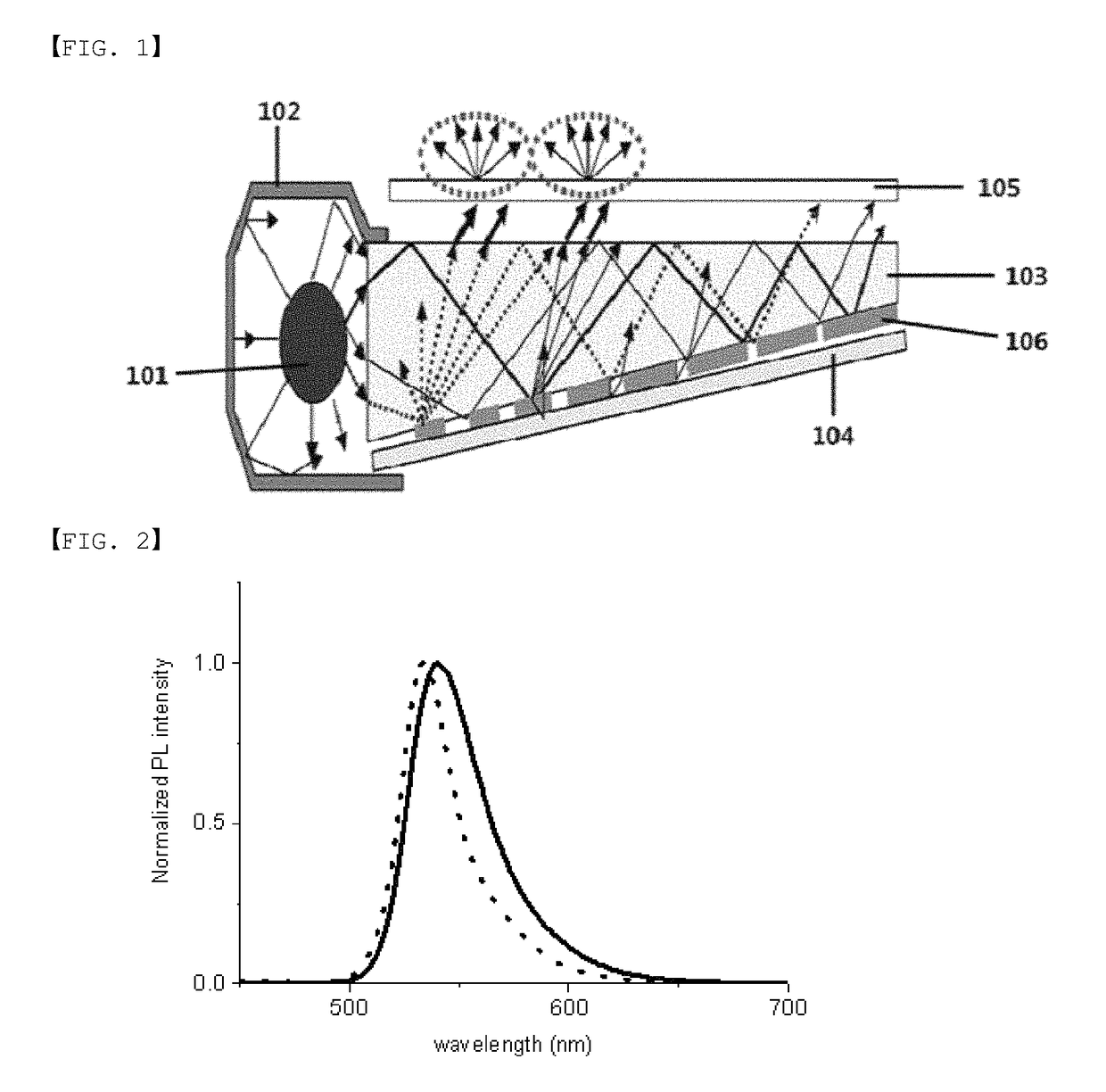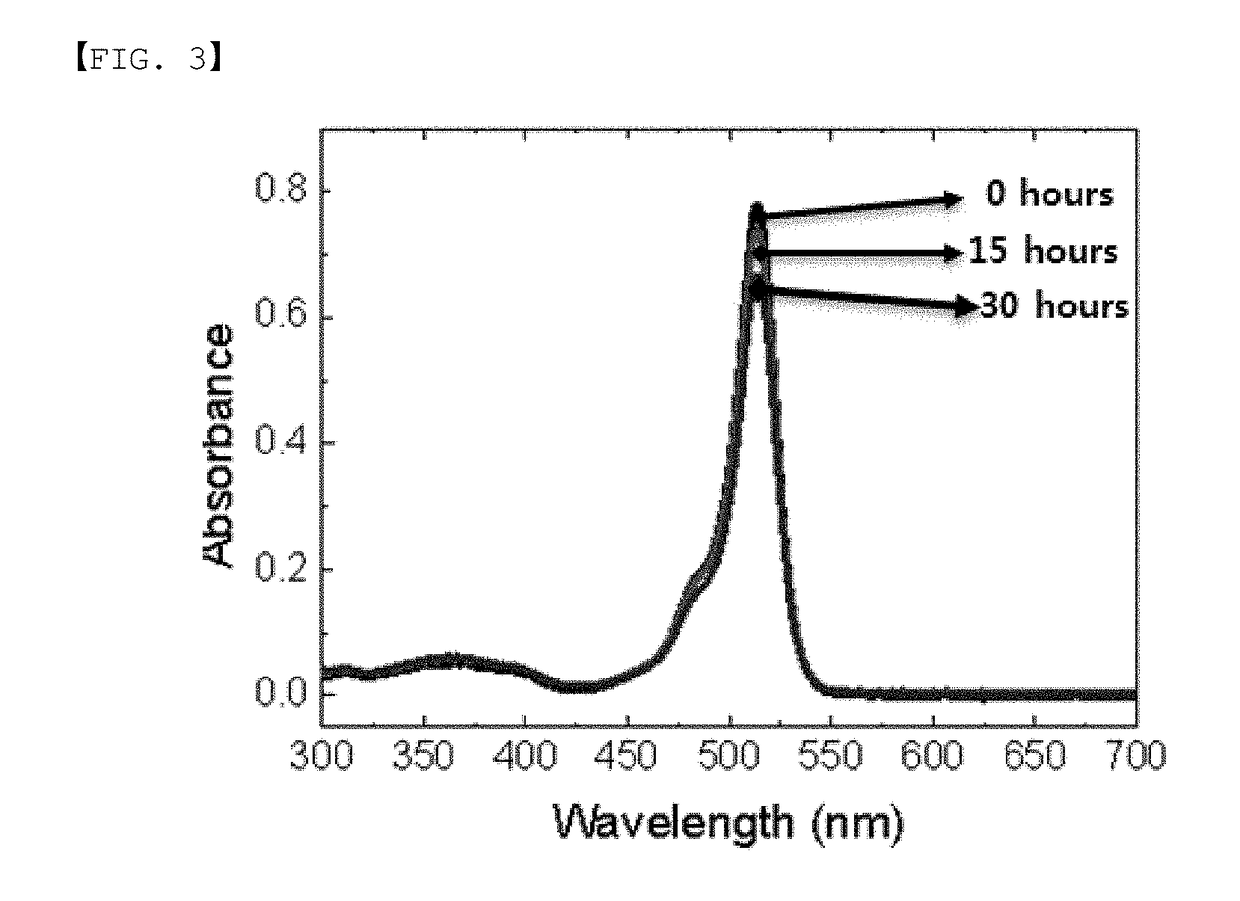Metal complex and color conversion film comprising same
a metal complex and color conversion technology, applied in the direction of group 3/13 element organic compounds, semiconductor devices for light sources, lighting and heating apparatus, etc., can solve the problems of poor color rendering, inferior color gamut, safety problems of cadmium series quantum dots, etc., to reduce efficiency, reduce oxidation potential, and high efficiency
- Summary
- Abstract
- Description
- Claims
- Application Information
AI Technical Summary
Benefits of technology
Problems solved by technology
Method used
Image
Examples
reference examples 1 to 3
[0146]In order to examine spectroscopic properties and light stability of the following Compounds 1 to 3 and 1-40, light emission spectra in a solution state (toluene 1×10−5 M) were measured, and stability of the molecules themselves for light was evaluated through absorbance differences by time by measuring UV-vis spectra under a blue backlight.
[0147]
[0148]FIG. 2 shows light emission spectra (toluene 1×10−5 M) of Compound 1 (dotted line) and Compound 2 (straight line). As shown in FIG. 2, it was identified that, when ortho-fluorophenyl substitutes, the light emission wavelength was suitable for green compared to Compound 2, and the half-width significantly decreased.
[0149]FIG. 3 and FIG. 4 each show changes in the UV-vis spectra of Compound 1 and Compound 3 by time under blue light. FIG. 5 shows absorbance variation in the maximum absorption wavelengths of Compound 1 (▪) and Compound 3 (♦) by time (toluene 1×10−5 M). It was seen that Compound 1 substituted with ortho-fluorophenyl h...
synthesis example 1
Preparation of Compound 1-9
[0151]
[0152]Preparation of Compound P1: After mixing 2,4-dimethylpyrrole (10 g, 0.10 mol), mesityl aldehyde (7.8 g, 0.052 mol), trifluoroacetic acid (2 drops), and dry dichloromethane (500 mL) in a flask, the result was stirred for 5 hours at room temperature under nitrogen. After checking the disappearance of the starting materials using TLC, DDQ (12 g, 0.052 mol) was added thereto at 0° C. The result was stirred for 1 hour at room temperature, and then triethylamine (26 g, 0.25 mol) was slowly added dropwise thereto. After the result was stirred for 30 minutes at room temperature, a boron trifluoride ethyl ether complex (65 g, 0.46 mol) was slowly added dropwise thereto. The reactants were stirred for 5 hours at room temperature, water was added thereto, and the result was extracted using dichloromethane. The result was dried with anhydrous magnesium sulfate and filtered, and then vacuum distilled to remove the solvent. A red compound P1 (7.8 g, 40%) was...
synthesis example 2
Preparation of Compound 1-40
[0158]
[0159]Orange Compound 1-40 (0.43 g, 52%) was obtained in the same manner as in Synthesis Example 1 except that 2,2,3,3,4,4-heptafluorobutanol (0.31 g, 1.5 mmol) was used instead of n-butanol.
[M−F]+=667
PUM
| Property | Measurement | Unit |
|---|---|---|
| half-width | aaaaa | aaaaa |
| half-width | aaaaa | aaaaa |
| half-width | aaaaa | aaaaa |
Abstract
Description
Claims
Application Information
 Login to View More
Login to View More - R&D
- Intellectual Property
- Life Sciences
- Materials
- Tech Scout
- Unparalleled Data Quality
- Higher Quality Content
- 60% Fewer Hallucinations
Browse by: Latest US Patents, China's latest patents, Technical Efficacy Thesaurus, Application Domain, Technology Topic, Popular Technical Reports.
© 2025 PatSnap. All rights reserved.Legal|Privacy policy|Modern Slavery Act Transparency Statement|Sitemap|About US| Contact US: help@patsnap.com



